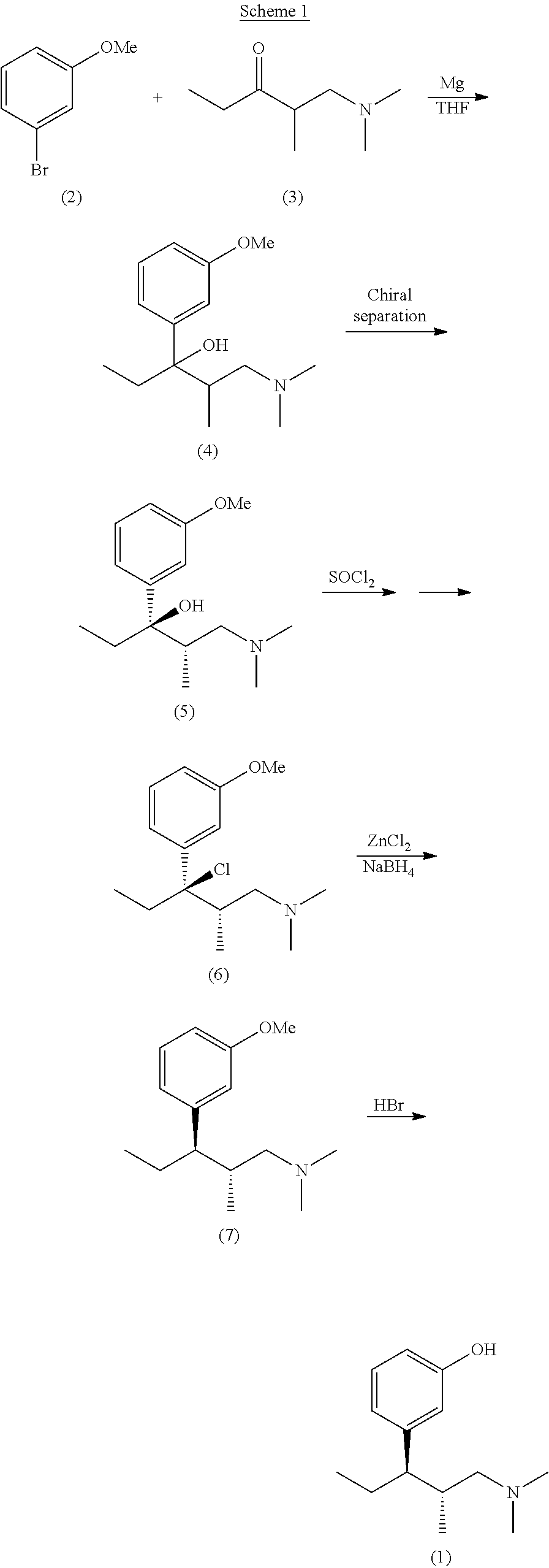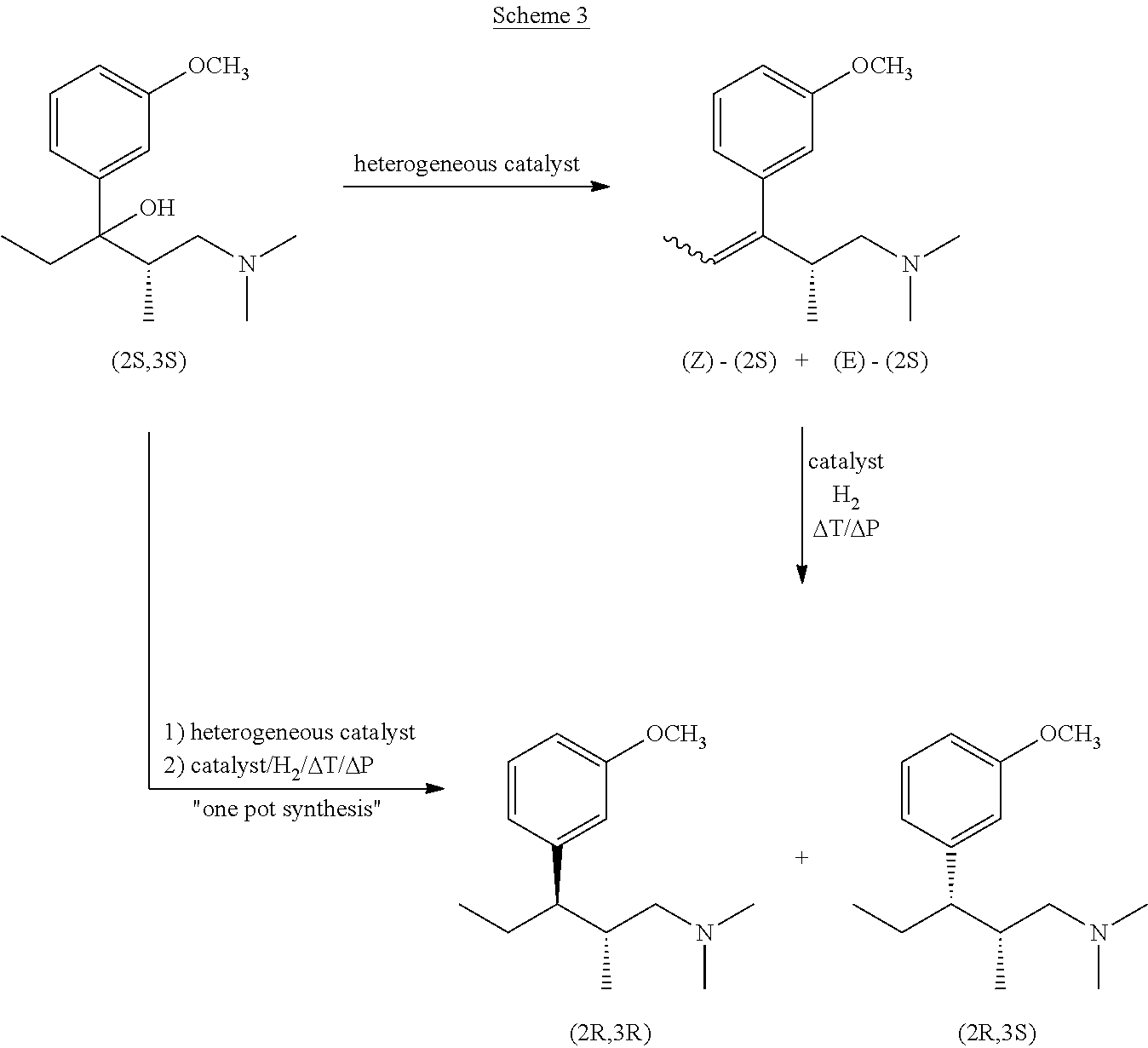Intermediate compounds and processes for the preparation of tapentadol and related compounds
a technology applied in the field of intermediate compounds and processes for the preparation of tapentadol and related compounds, can solve the problems of affecting the safety of use of hydrogenation reagents such as zinc cyanoborohydride, zinc cyanoborohydride, zinc cyanoborohydride, etc., and achieves the effect of convenient industrialization
- Summary
- Abstract
- Description
- Claims
- Application Information
AI Technical Summary
Benefits of technology
Problems solved by technology
Method used
Image
Examples
example 1
Preparation of bis(2,2,2-trifluoroethyl) 2-(dimethylamino)-2-oxoethylphosphonate (14)
[0248]
(i) By Michaelis-Becker Reaction
a). To a solution of imidazole (2.084 g, 30 mmol) in CH2Cl2 (20 mL) was added PCl3 (0.88 mL, 10 mmol) and then 2,2,2-trifluoroethanol (20 mmol) at 0° C. After stirring for 30 min, water (0.18 mL, 10 mmol) was added. The salt was removed by filtration, and the filtrate was treated with 2-bromo-N,N-dimethylacetamide (8 mmol) and triethylamine (1.69 mL, 12 mmol) at 0° C. for 10 min. The mixture was stirred for 5 h at 25 room temperature. The reaction was quenched with water (20 mL). Extraction and column chromatography (silica gel 35 g / hexane-AcOEt (8:1 to 5:1)) provided bis(2,2,2-trifluoroethyl) 2-(dimethylamino)-2-oxoethylphosphonate (48% from 2-bromo-N,N-dimethylacetamide) as a colorless oil.
[0249]1H NMR (400 MHz, CDCl3) δ: 3.25 (d, J=21.6 Hz, 2H), 3.47 (s, 6H), 4.43 (dq, J=8.3, 8.2 Hz, 4H); 13C NMR (100 MHz, CDCl3) δ: 37.1 (s, NMe2), 40.0 (d, J=145 Hz, P(O)CH2C...
example 2
Preparation of [1-(Dimethylcarbamoyl)ethyl]phosphonic acid bis-(2,2,2-trifluoroethyl) ester (15)
[0258]
a). Bis(2,2,2-trifluoroethyl) 2-(dimethylamino)-2-oxoethylphosphonate (14) (4.7 g, 14.2 mmol) was slowly added to a solution of tert-BuOK (1.9 g, 17.0 mmol) in THF (20 ml) at 0° C. under nitrogen atmosphere. The mixture was stirred at these conditions for 30 minutes methyl iodide (4.42 ml, 70.9 mmol) was slowly added keeping the temperature at 0° C. After stirring at room temperature for 14 h under nitrogen atmosphere, the reaction mixture was treated with saturated aqueous solution of NH4Cl and then extracted with AcOEt (50 ml×3). The extracts were concentrated t to give an oily residue, which was purified by vacuum distillation or column chromatography on silica gel [n-hexane / AcOEt (2:1)] to afford 3.2 g of the wanted compound(65%) as a colorless oil.
[0259]1H-NMR (400 MHz, CDCl3) δ: 1.52 (dd, J=19.8 Hz, J=7.3 Hz, 3H), 3.48 (s, 6H), 3.87 (1H, dq, J=22.9 Hz, J=7.3 Hz), 4.40 (dq, J=8...
example 3
Preparation of methyl 3-(3-methoxyphenyl)-2-methylpent-2-enoate (16, R′═OCH3)
a). HWE Reaction with Sn(OSO2CF3)2
[0265]A solution of Ethyl-2-[Bis(2,2,2-trifluoroethyl)phosphonopropionate (1.24 mmol) in anhydrous dichloroethane (5 ml) was added to a suspension of Sn(OSO2CF3)2 (0.6 g, 1.48 mmol) in anhydrous dichloroethane (10 ml) and stirred at room temperature for min under argon. After adding N-ethylpiperidine (0.15 g, 1.36 mmol), the mixture was 10 stirred at 0° C. for 1 h under argon atmosphere, and then heated to reflux. 3-methoxy phenyl ethyl ketone (11) (0.14 g, 0.88 mmol) was slowly added to the refluxing solution. Following reflux under TLC or GC control for completion of the reaction (18-20 h) under argon atmosphere, the reaction mixture was poured into water (10 ml) and then extracted with methylene chloride or chloroform (20 ml×3). Hexane (50 ml) was added to the organic extracts, and the mixture was submitted to filtration through a silica gel short column [n-hexane / CHCl3...
PUM
| Property | Measurement | Unit |
|---|---|---|
| pressure | aaaaa | aaaaa |
| pressure | aaaaa | aaaaa |
| hydrogen pressure | aaaaa | aaaaa |
Abstract
Description
Claims
Application Information
 Login to View More
Login to View More - R&D
- Intellectual Property
- Life Sciences
- Materials
- Tech Scout
- Unparalleled Data Quality
- Higher Quality Content
- 60% Fewer Hallucinations
Browse by: Latest US Patents, China's latest patents, Technical Efficacy Thesaurus, Application Domain, Technology Topic, Popular Technical Reports.
© 2025 PatSnap. All rights reserved.Legal|Privacy policy|Modern Slavery Act Transparency Statement|Sitemap|About US| Contact US: help@patsnap.com



